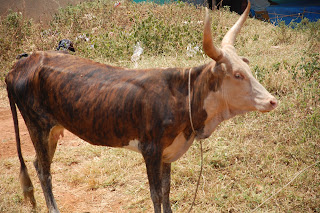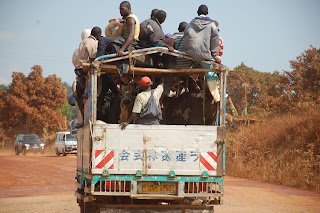Today was a travel day from Kampala to Port Fortal in western Uganda. We traveled in a comfortable 20 person bus
from about 9 am until 4 pm, at which time we had a lunch. I was lucky enough to get the front seat of
the bus beside the driver so I got the perfect view for the trip. Unlike Canada, where we typically have
either 2 or 4 lane highways to get us between cities, the highways are quite
slow. This was mainly because you have
to slow down every time you pass through a small developed area (which is
often) or you pass by a school. They use
a series of small speed bumps instead of a yield sign to slow you down which
makes for a very rough ride. To-date, I have
not seen a traffic lights in Uganda
and I don’t think they exist, only speed bumps and round-abouts.
Along the way, I took several pictures of the
countryside to help me remember this place which is very different from Canada
in most ways. Here is are some of the
noticeable differences: people everywhere; bicycles to transport anything
(especially green bananas); speed bumps; crazy drivers, lots of motorcycles (sometimes
with many passengers); thin cows and goats tied up with ropes along the road
side; multiple people in the back of trucks (including big ones); burning
grass/brush along the side of the road; and lastly (but most common) is people
walking/biking to pick up their daily water.
 |
| Typical roadside view in a developed area |
 |
| Getting water for the day |
 |
| 6 passengers (kids) on a motorcycle (no need for a mini-van) |
 |
| skinny cow along side of the road |
 |
| Transporting large bunches of bananas |
 |
| a truck full of cows & people |
The country side itself consists of rolling
hills with very little flat land and red soil almost everywhere. The water supplies are typically shallow
wells or springs at the base of the hills.
Most rural properties use the land to host a few animals like goats,
chickens and cows and grow crops like potatoes, corn and bananas. These agricultural activities are very
different from Canada as
they use no machines (or chemicals) whatsoever. Things are done at a very
small scale, similar to the way it was in Canada
many years ago.
As we approached Fort Portal,
much of the land was planted with tea plants.
We stopped at a tea factory (premium black tea) and had a tour.
Once we arrived in Fort Portal
and had lunch, we visit the office of another one WaterCans’ partner
organizations who implement projects.
They are known as JESE which stands for ‘Joint Effort to Save the
Environment’. We did introductions and
then JESE staff presented an overview of their work. Following the meeting, we took a quick look
at their new building.
Then we checked in at the Ruwenzori View
Guest House which is located just outside of Fort Portal,
in a scenic area. We ate dinner together
with some of the JESE staff at the ‘Mountains of the moon’ hotel (quite nice).


Amazing photos and text Brian. Thanks for sharing this experience with all of us.
ReplyDeleteSounded like a good day of travel. Great pcs Brian :)
ReplyDelete